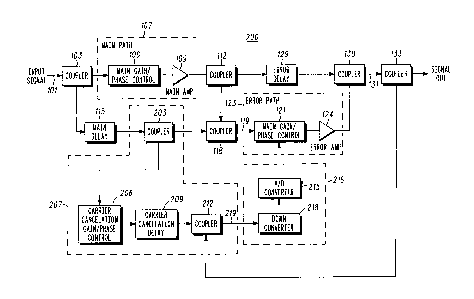Some of the information on this Web page has been provided by external sources. The Government of Canada is not responsible for the accuracy, reliability or currency of the information supplied by external sources. Users wishing to rely upon this information should consult directly with the source of the information. Content provided by external sources is not subject to official languages, privacy and accessibility requirements.
Any discrepancies in the text and image of the Claims and Abstract are due to differing posting times. Text of the Claims and Abstract are posted:
| (12) Patent Application: | (11) CA 2227313 |
|---|---|
| (54) English Title: | METHOD AND APPARATUS FOR IMPROVING ERROR PATH CONTROL IN A FEED-FORWARD AMPLIFIER |
| (54) French Title: | COMMANDE DE CHEMIN D'ERREUR DESTINEE A UN AMPLIFICATEUR A CORRECTION AVAL |
| Status: | Deemed Abandoned and Beyond the Period of Reinstatement - Pending Response to Notice of Disregarded Communication |
| (51) International Patent Classification (IPC): |
|
|---|---|
| (72) Inventors : |
|
| (73) Owners : |
|
| (71) Applicants : |
|
| (74) Agent: | GOWLING WLG (CANADA) LLP |
| (74) Associate agent: | |
| (45) Issued: | |
| (86) PCT Filing Date: | 1997-02-13 |
| (87) Open to Public Inspection: | 1997-11-27 |
| Examination requested: | 1998-01-15 |
| Availability of licence: | N/A |
| Dedicated to the Public: | N/A |
| (25) Language of filing: | English |
| Patent Cooperation Treaty (PCT): | Yes |
|---|---|
| (86) PCT Filing Number: | PCT/US1997/002367 |
| (87) International Publication Number: | US1997002367 |
| (85) National Entry: | 1998-01-15 |
| (30) Application Priority Data: | ||||||
|---|---|---|---|---|---|---|
|
A feed-forward amplifier (200) bases control of an error path (123) within the
feed-forward amplifier (200) on an output signal after performing carrier
cancellation to remove the carrier signal. The feed-forward amplifier (200)
implements couplers (203, 212), a carrier cancellation gain/phase control
block (206) and a carrier cancellation delay block (209) to cancel the carrier
signal. By basing the control of the error path on a signal without the
carrier signal, control of the error path (123) does not suffer from the
effects of high dynamic range presented by the carrier signal, thus improving
overall control of the feed-forward amplifier (200).
Cet amplificateur à correction aval (200) base la commande d'un chemin d'erreur (123) sur un signal de sortie, après avoir annulé la porteuse afin d'enlever le signal de celle-ci. Cet amplificateur (200) met également en oeuvre des coupleurs (203, 212), un bloc de commande (206) de gain/phase d'annulation de la porteuse, ainsi qu'un bloc de temporisation (209) d'annulation de la porteuse, afin d'annuler le signal de la porteuse. En basant la commande du chemin d'erreur (123) sur un signal dépourvu du signal de la porteuse, cette commande ne subit par les effets du champ dynamique élevé présenté par le signal de la porteuse, améliorant ainsi la commande globale de l'amplificateur (200) à correction aval.
Note: Claims are shown in the official language in which they were submitted.
Note: Descriptions are shown in the official language in which they were submitted.

2024-08-01:As part of the Next Generation Patents (NGP) transition, the Canadian Patents Database (CPD) now contains a more detailed Event History, which replicates the Event Log of our new back-office solution.
Please note that "Inactive:" events refers to events no longer in use in our new back-office solution.
For a clearer understanding of the status of the application/patent presented on this page, the site Disclaimer , as well as the definitions for Patent , Event History , Maintenance Fee and Payment History should be consulted.
| Description | Date |
|---|---|
| Inactive: IPC expired | 2009-01-01 |
| Inactive: IPC from MCD | 2006-03-12 |
| Deemed Abandoned - Failure to Respond to Maintenance Fee Notice | 2001-02-13 |
| Application Not Reinstated by Deadline | 2001-02-05 |
| Inactive: Dead - No reply to s.30(2) Rules requisition | 2001-02-05 |
| Inactive: Abandoned - No reply to s.30(2) Rules requisition | 2000-02-04 |
| Inactive: S.30(2) Rules - Examiner requisition | 1999-08-04 |
| Inactive: IPC assigned | 1998-05-06 |
| Classification Modified | 1998-05-05 |
| Inactive: IPC assigned | 1998-05-05 |
| Inactive: First IPC assigned | 1998-05-05 |
| Inactive: Acknowledgment of national entry - RFE | 1998-04-15 |
| Inactive: Applicant deleted | 1998-04-15 |
| Application Received - PCT | 1998-04-14 |
| Request for Examination Requirements Determined Compliant | 1998-01-15 |
| All Requirements for Examination Determined Compliant | 1998-01-15 |
| Application Published (Open to Public Inspection) | 1997-11-27 |
| Abandonment Date | Reason | Reinstatement Date |
|---|---|---|
| 2001-02-13 |
The last payment was received on 1999-12-14
Note : If the full payment has not been received on or before the date indicated, a further fee may be required which may be one of the following
Patent fees are adjusted on the 1st of January every year. The amounts above are the current amounts if received by December 31 of the current year.
Please refer to the CIPO
Patent Fees
web page to see all current fee amounts.
| Fee Type | Anniversary Year | Due Date | Paid Date |
|---|---|---|---|
| Registration of a document | 1998-01-15 | ||
| Request for examination - standard | 1998-01-15 | ||
| Basic national fee - standard | 1998-01-15 | ||
| MF (application, 2nd anniv.) - standard | 02 | 1999-02-15 | 1998-12-22 |
| MF (application, 3rd anniv.) - standard | 03 | 2000-02-14 | 1999-12-14 |
Note: Records showing the ownership history in alphabetical order.
| Current Owners on Record |
|---|
| MOTOROLA, INC. |
| Past Owners on Record |
|---|
| MARK IAN VAN HORN |